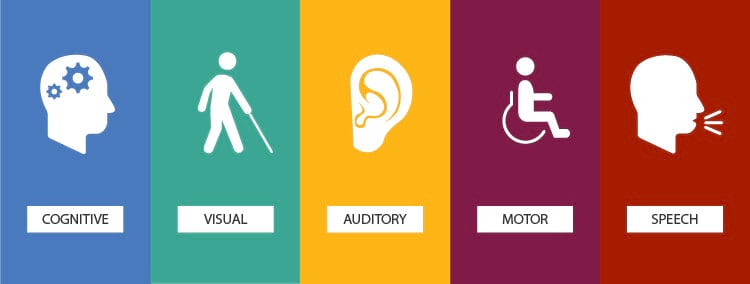
What is accessibility
Before we dive into what web accessibility means, let’s first understand what accessibility in general means. Accessibility is the extent to which something is able to be accessed by everyone, regardless of their abilities or disabilities. Buildings, public transportation, web applications, or other things we use in our daily lives are accessible if everyone can use these things. For example, most public buildings have ramps or elevators in addition to stairs to provide access to wheelchairs, and many speeches by public figures have a sign language interpreter so people with hearing disabilities can access the spoken content. The end goal is to enable access to all possible things for people with disabilities, not only because it is required by law, but because it is right thing to do.
The CDC defines disability as “Any condition of the body or mind (impairment) that makes it more difficult for the person with the condition to do certain activities (activity limitation) and interact with the world around them (participation restrictions).” It is important to understand that disabilities can be permanent, temporary, or situation based. Disabilities can be classified into the following categories: motor, cognition, vision, hearing, and speech.
Web accessibility is a way to make web content easy to read, perceive, navigate, and interact for people with disabilities. It provides people with disabilities equal access and equal opportunity to access content on the internet. A web accessible product allows more users to participate and engage with the web content.
Accessibility in ArcGIS StoryMaps
ArcGIS StoryMaps has been evaluated for conformance according to WCAG 2.0 AA, WCAG 2.1 AA, and the Revised Section 508 standards. This evaluation is also known as a Voluntary Product Accessibility Template—or VPAT—and it explains the extent to which a product like StoryMaps adheres to such important accessibility guidelines. The results of the ArcGIS StoryMaps evaluation are available through our Accessibility Conformance Report.
Now let’s go through what we are doing to make ArcGIS StoryMaps accessible to provide a better experience to people with each type of disability.
Motor disabilities
Many people with motor disabilities cannot use a traditional mouse or keyboard to surf the web for a variety of reasons – including weakness, tremors in their hands, or an underlying neurological condition – and instead rely on a keyboard variant like a one-handed keyboard, an adaptive keyboard, or other alternatives. For these users, it’s essential that links, buttons, and other interactive elements on a web page can be reached and engaged with solely using a keyboard. It is also important for keyboard navigators to know which item on the page has “focus” at any given time, which is roughly equivalent to a mouse user knowing where her mouse is pointing on a page. To accomplish this, web pages need some sort of visual indication of item focus for keyboard navigators. This usually takes the form of a colored outline around the focused item.
We made a few improvements to keyboard and tab navigation for both authors and readers in our July StoryMaps release to ensure keyboard-navigating users have access to all the interactive elements on the page. We have also improved visual focus indicators within the story builder, increasing the color contrast and width of these outlines. In the future, we plan to add a skip navigation link to allow keyboard navigators to move focus directly to the main content of the page.
Cognitive disabilities
Having an easy to use web interface with an intuitive flow makes a big difference for people with cognitive disabilities, as they may have trouble processing information, learning new things, or concentrating. Intuitive pages have a clear structure, navigating left to right and top to bottom. The content should be clear and precise, and should use easy to understand language.
Since we started building the product, we have been making consistent efforts to ensure ArcGIS StoryMaps is easy to understand for everyone, including people with cognitive disabilities. Within our builder, we offer clear, simple menus for selecting themes, accent colors, and basemaps. We have added Verdana Pro font in the theme builder which has improved readability that may help many people with dyslexia. We continually strive for an easy to use interface in the builder and published stories, ensuring our product is accessible to the widest range of people possible.
Vision disabilities
There is a wide range of vision disabilities, from color blindness to light and movement sensitivities, obstructed vision, low vision, or no vision. For those with color blindness, the color contrast of UI elements should conform to the standards defined by the Web Content Accessibility Guidelines. What’s more, information should not rely on color alone for meaning – for instance, if a link is a different color than the surrounding text, it should also have an underline or other non-color indicator that it is a link. For those with sensitivity to light and movement, web page designers should consider reducing animation effects, offering a dark mode, or providing a simplified reading experience. For partially sighted users, related UI components should be tightly grouped together, so that users who rely on magnification can still see related elements in the same small area. For non-sighted users, screen reader assistive technology software is available.
Our design team has been very proactive in supporting people with vision disabilities, to make sure the color contrast of UI elements on our website meets the required standards. We also provide authors the ability to add alternative text to images, videos, maps and other media, which is used by screen readers to help non-sighted users understand the purpose of the media in context of the story. In our latest release, we improved screen reader announcements throughout the story builder to include nudges and alert messages, media toolbar buttons, and device preview buttons. We have also improved semantic structuring and use of roles throughout our pages, enabling screen readers to better utilize landmarks for navigating a page.
Hearing disabilities
A web application with audio output needs to ensure that users with hearing disabilities have an alternative way to access that information.
We recently added the ability to include audio in stories and are exploring options for providing text captions or subtitles to make this content accessible in a future release.
____________
On Esri’s StoryMaps team, we are committed to making our product highly accessible and will continue to keep working towards that goal to give a better storytelling and reading experience for the members of our community, who make ArcGIS StoryMaps a successful product.
Storytellers can reference this blog article about best practices in making your stories on ArcGIS StoryMaps as accessible as possible.

Commenting is not enabled for this article.